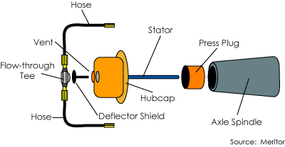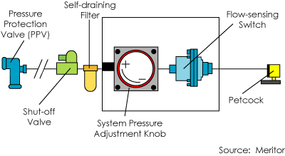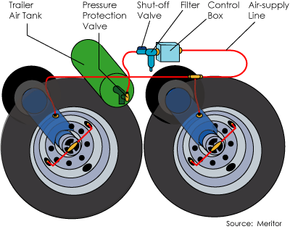Meritor Tire Inflation System
The Meritor Tire Inflation System (MTIS) is designed for use on tractor trailers. It uses compressed air from the trailer to inflate any tire that falls below its appropriate pressure. Air from the existing trailer air supply is routed to a control box and then into each axle.
The air lines run through the axles to carry air through a rotary union assembly at the spindle end in order to distribute air to each tire. If there is significant air-pressure loss, an indicator light informs the driver.
Advertisement
The overall system is made up of a wheel-end assembly and a control module.

Wheel-end Assembly
The wheel-end assembly includes a flexible hose with check valves. The check valves only allow air to flow into each tire; this ensures that while one tire is being inflated, the other tires don't lose air pressure.
This assembly also incorporates a stator (a non-rotating part) inside the axle spindle and a flow-through tee that is attached to the hubcap. The flow-through tee has a dynamic seal to allow rotation while preventing pressure loss when pressurized air passes from the axle to the hub, which occurs through a tube that runs from the stator into the tee.
In the hubcap assembly, there is a vent to make sure pressure does not build up in the wheel end. A deflector shield keeps contaminants such as dirt and water from entering the wheel end.
For axles with hollow spindles, a press plug seals the pressurized axle interior from the wheel end in order to secure the stator.

Controls
The system control module has a shut-off valve to stop air from being sent to the system, as well as a filter to remove moisture and contaminants. The petcock releases system pressure so maintenance can be performed. Like some of the other systems that use onboard air supplies, this system has a pressure protection valve so that it won't pull air if the air supply is below 80 psi.
A system pressure adjustment knob allows for adjustments to the overall system air pressure. A flow-sensing switch activates the indicator light to let the driver knows if a significant amount of air is being pumped into a tire, which would indicate a potential puncture.
